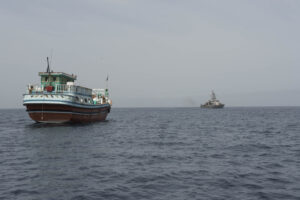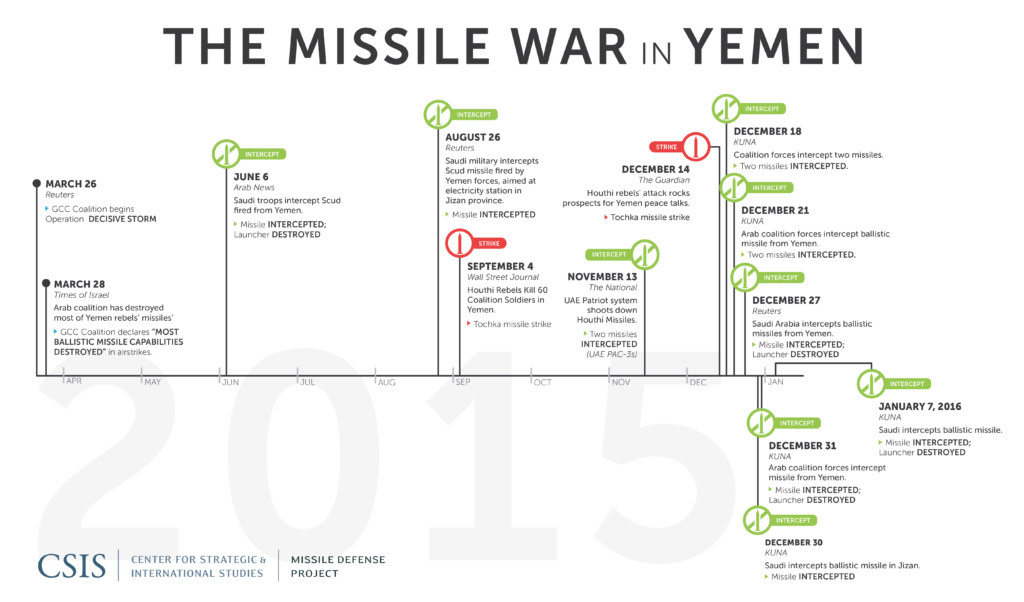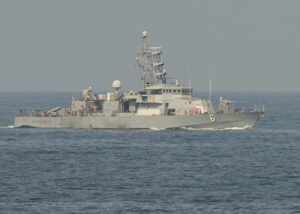Navy Seizes 1,700 Iranian Weapons Bound For Yemen’s Houthi Rebels
Posted on

Some of the 1,500 AK-47 assault rifles seized by the Navy on Friday, believed to be an Iranian shipment for Yemen’s Houthi rebels
We write a lot on this site about high-tech, high-cost weapons. But it’s worth remembering that most of the killing around the world, an estimated 200,000 deaths a year, takes place with low-tech tools, like these AK-47 assault rifles the Navy seized Friday in the Arabian Sea. All told, the small cargo ship carried 21 fifty-caliber machineguns, 200 rocket-propelled grenade (RPG) launchers, and a staggering 1,500 AK-47s.
Their origin, according to the US Navy? Iran. Their destination? The Houthi rebels in Yemen.

The vessel that carried the weapons, with the intercepting USS Sirocco in the distance.
The Houthis have hit the Saudi army’s US-made M1 tanks with sophisticated guided missiles. They’ve even fired short-ranged ballistic missiles — cousins of Saddam Hussein’s Scuds — at Saudi targets to deadly effect. The Saudis have responded with the famous Patriot missile defense system, sometimes shooting down the incoming Houthi missiles and sometimes not. (See the graphic timeline below by Tom Karako & co. of CSIS).
This confounding combination of low-tech and high, of irregular militias with weapons once reserved for states, is known to many military theorists as a “hybrid” threat. Vladimir Putin’s use of separatist proxies and deniable “little green men” is arguably a case of hybrid warfare practiced by a major power. And Daesh, the self-proclaimed Islamic State, presents a threat that combines transnational terrorism, a popular (Sunni Arab) insurgency, and conventional fighting for territory.

CSIS graphic courtesy Tom Karako & Iain Williams
The US is struggling to adapt to this ambiguity. A military largely organized and equipped during the Cold War for state-on-state conflict, but consumed for the last 15 years by counterinsurgency, is trying to figure out how to respond to adversaries who blur those categories.

The patrol craft USS Sirocco, which seized the weapons.
Certainly the US Navy and its partners have been vigilant. The small smuggling craft was seized by one of the US Navy’s own smaller vessels, the 380-ton Cyclone-class coastal patrol craft Sirocco, but the 9,000-ton destroyer Gravely moved in as backup. The need for pinch-hitter warships — larger than the Cyclones but less expensive than destroyers, able to either conduct patrols in peacetime or support the battle fleet in wartime — is one of the major arguments for the controversial Littoral Combat Ship.
“This seizure was the third time in recent weeks international naval forces operating in the waters of the Arabian Sea seized a shipment of illicit arms which the United States assessed originated in Iran and was likely bound for Houthi insurgents in Yemen,” said a Navy statement.
What else do the Iranians think will help the Houthis? The Royal Australian Navy’s HMAS Darwin stopped a boat Feb. 27 that was carrying nearly 2,000 Kalashnikov rifles, 100 RPG launchers, 49 PKM machine guns, 39 PKM machine gun barrels and 20 60mm mortar tubes. And the French Navy destroyer FS Provence intercepted a cargo on March 20 that included about 2,000 Kalashnikov rifles, 64 Dragunov sniper rifles, nine anti-tank missiles and other gear, the US Navy said.
Whatever you think of the Iranian nuclear deal, this small-arms traffic at sea is a reminder that Tehran has other lethal ways to achieve its objectives. It should remind us that our adversaries are persistent, flexible, and inventive — and that we need to be, too.

Seized RPG launchers.
Subscribe to our newsletter
Promotions, new products and sales. Directly to your inbox.
